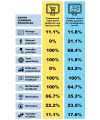Integration of Motor Learning Principles Into Virtual Reality Interventions for Individuals With Cerebral Palsy: Systematic Review
- PMID: 33825690
- PMCID: PMC8060861
- DOI: 10.2196/23822
Integration of Motor Learning Principles Into Virtual Reality Interventions for Individuals With Cerebral Palsy: Systematic Review
Abstract
Background: Increasing evidence supports the use of virtual reality systems to improve upper limb motor functions in individuals with cerebral palsy. While virtual reality offers the possibility to include key components to promote motor learning, it remains unclear if and how motor learning principles are incorporated into the development of rehabilitation interventions using virtual reality.
Objective: The objective of this study was to determine the extent to which motor learning principles are integrated into virtual reality interventions targeting upper limb function in individuals with cerebral palsy.
Methods: A systematic review was conducted according to the PRISMA (Preferred Reporting Items for Systematic Reviews and Meta-Analyses) guidelines. The search was performed in 10 databases using a combination of keywords related to cerebral palsy, virtual reality, video games, and rehabilitation. Studies were divided into 2 categories: commercial video game platforms and devices and custom virtual reality systems. Study quality was assessed using the modified Downs and Black checklist.
Results: The initial search yielded 1497 publications. A total of 26 studies from 30 publications were included, with most studies classified as "fair" according to the modified Downs and Black checklist. The majority of studies provided enhanced feedback and variable practice and used functionally relevant and motivating virtual tasks. The dosage varied greatly (total training time ranged from 300 to 3360 minutes), with only 6 studies reporting the number of movement repetitions per session. The difficulty progression and the assessment of skills retention and transfer were poorly incorporated, especially for the commercial video games.
Conclusions: Motor learning principles should be better integrated into the development of future virtual reality systems for optimal upper limb motor recovery in individuals with cerebral palsy.
Trial registration: PROSPERO International Prospective Register of Systematic Reviews CRD42020151982; https://www.crd.york.ac.uk/prospero/display_record.php?ID=CRD42020151982.
Keywords: active video games; brain damage; feedback; learning; upper limb; virtual rehabilitation.
©Marika Demers, Karen Fung, Sandeep K Subramanian, Martin Lemay, Maxime T Robert. Originally published in JMIR Serious Games (http://games.jmir.org), 07.04.2021.
Conflict of interest statement
Conflicts of Interest: None declared.
Figures



Similar articles
-
Short- to Long-Term Effects of Virtual Reality on Motor Skill Learning in Children With Cerebral Palsy: Systematic Review and Meta-Analysis.JMIR Serious Games. 2023 Sep 12;11:e42067. doi: 10.2196/42067. JMIR Serious Games. 2023. PMID: 37698895 Free PMC article. Review.
-
Effects of virtual reality motor games on motor skills in children with cerebral palsy: a systematic review and meta-analysis.Front Psychol. 2025 Jan 6;15:1483370. doi: 10.3389/fpsyg.2024.1483370. eCollection 2024. Front Psychol. 2025. PMID: 39881687 Free PMC article.
-
Effectiveness of virtual reality interventions of the upper limb in children and young adults with cerebral palsy: A systematic review with meta-analysis.Clin Rehabil. 2024 Jan;38(1):15-33. doi: 10.1177/02692155231187858. Epub 2023 Jul 27. Clin Rehabil. 2024. PMID: 37499213
-
Serious Game Design and Clinical Improvement in Physical Rehabilitation: Systematic Review.JMIR Serious Games. 2021 Sep 23;9(3):e20066. doi: 10.2196/20066. JMIR Serious Games. 2021. PMID: 34554102 Free PMC article. Review.
-
Motor performance of individuals with cerebral palsy in a virtual game using a mobile phone.Disabil Rehabil Assist Technol. 2018 Aug;13(6):609-613. doi: 10.1080/17483107.2017.1392620. Epub 2017 Nov 1. Disabil Rehabil Assist Technol. 2018. PMID: 29092683
Cited by
-
Gamification for Distal Radius Fracture Rehabilitation: A Randomized Controlled Pilot Study.Cureus. 2022 Sep 19;14(9):e29333. doi: 10.7759/cureus.29333. eCollection 2022 Sep. Cureus. 2022. PMID: 36277562 Free PMC article.
-
Effects of a multi-component virtual reality program on motor skills and functional postural control in children with hemiplegic cerebral palsy.Heliyon. 2023 Sep 9;9(9):e19883. doi: 10.1016/j.heliyon.2023.e19883. eCollection 2023 Sep. Heliyon. 2023. PMID: 37809784 Free PMC article.
-
Evaluation of a Game-Based Mechatronic Device for Rehabilitation of Hand-Arm Function in Children With Cerebral Palsy: Feasibility Randomized Controlled Trial.JMIR Rehabil Assist Technol. 2025 Feb 18;12:e65358. doi: 10.2196/65358. JMIR Rehabil Assist Technol. 2025. PMID: 39964707 Free PMC article.
-
Rapid Synthesis of the Literature on the Evolution of Gamification in Distal Radial Fracture Rehabilitation.Cureus. 2022 Sep 20;14(9):e29382. doi: 10.7759/cureus.29382. eCollection 2022 Sep. Cureus. 2022. PMID: 36304351 Free PMC article. Review.
-
Impact of Sensory Deficits on Upper Limb Motor Performance in Individuals with Cerebral Palsy: A Systematic Review.Brain Sci. 2021 Jun 3;11(6):744. doi: 10.3390/brainsci11060744. Brain Sci. 2021. PMID: 34205153 Free PMC article. Review.
References
-
- Bishop DVM. Which neurodevelopmental disorders get researched and why? PLoS One. 2010 Nov 30;5(11):e15112. doi: 10.1371/journal.pone.0015112. https://dx.plos.org/10.1371/journal.pone.0015112 - DOI - DOI - PMC - PubMed
-
- Rosenbaum Peter, Paneth Nigel, Leviton Alan, Goldstein Murray, Bax Martin, Damiano Diane, Dan Bernard, Jacobsson Bo. A report: the definition and classification of cerebral palsy April 2006. Dev Med Child Neurol Suppl. 2007 Feb;109:8–14. - PubMed
LinkOut - more resources
Full Text Sources
Medical

